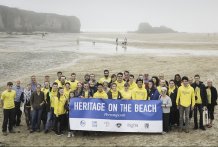
Heritage on the Beach day at Perranporth
Work to highlight Perranporth’s mining history wins at the first Cornwall Heritage Awards
Work by archaeologists and historians to highlight Perranporth’s incredible mining history has been honoured at the first Cornwall Heritage Awards.
Experts from the University of Exeter and Perranzabuloe Museum have partnered to remind the public that much of the scenic remains on the town’s beach are a result of ancient and historic mining. Their efforts earned them the “Audience Initiative” prize at the awards, held earlier this month.
Experts are studying the little-known mining history of the vulnerable cliffs overlooking the beach at Perranporth to show if the search for tin and copper in the area began in medieval or even prehistoric times. Thousands of visitors enjoy the town’s beautiful beach, but many don’t realise that many of the caves and huge rock arches in the cliffs are man-made. The coast was used for mining rather than leisure in the past, with the solid rock being tunnelled through by miners.
University of Exeter archaeologist Dr Gillian Juleff, who grew up in the area, is running a new research project, called Time and Tide, in collaboration with Perranzabuloe Museum, Perranzabuloe Parish Council, Dr Nicola Whyte at the Department of Humanities at the University’s Penryn campus and Dr Kate Moore from the Camborne School of Mines.
During a special Heritage on the Beach day at Perranporth in September, University of Exeter students ran a public survey to gather data on people’s perceptions of the cliff-scape, their awareness of the mining history and how they use the beach. The 450 members of the public who visited the beach on the day and responded to the survey were also able to join pop-up talks on the beach on mining, geology, archaeological survey, Poldark, St Piran and beach art given by Museum members and staff from Camborne School of Mines.
Those behind the project were also presented with a cash prize of £500 to help support the museum which is volunteer-run and has celebrated its 30th anniversary this year.. This money has been kindly granted by Heritage Lottery Fund.
Karin Easton, Honorary Secretary at Perranzabuloe Museum, said: “Heritage on the Beach was a wonderful opportunity to work with University of Exeter students and to get such good feedback from the public. We were delighted to engage with a new audience for the first time and introduce so many more people to the museum and our heritage.”
Dr Juleff said: “Most people don’t associate Perranporth beach with heritage. It is a place of wild natural beauty and many thousands of visitors come enjoy sea, sand and cliffs. They don’t realise much of the mining of Perranporth’s cliffs predates the building of Cornwall’s signature engine houses. Increasing winter storms and the processes of erosion that have exposed mine features now threaten their survival.
“Support from the Cornwall Heritage Awards will help us spread the word about Perranporth’s ancient history, and we are delighted to have our work honoured in this way.”
Heritage on the Beach was supported by a grant from the University of Exeter’s Annual Fund, which is an alumni fund directed towards student-related activities. Information from the survey taken during the event suggests the majority of visitors to the beach are unaware of the mining heritage that is visible in the cliffs. This data collected will support future research and has been shared with the Parish Council who own the beach and have responsibility for policy-making.
In their first year, the Cornwall Heritage Awards have been developed to commend museums and heritage organisations’ achievements, celebrate what makes them so special and to give those unsung heroes their greatly deserved moment in the spotlight. Award winners were further honoured with invitations to meet Prince Charles during his recent visit the Royal Cornwall Museum in Truro. The Awards have been organised by South West Museum Development in collaboration with Cornwall Museums Partnership, and were made possible by investment from the Heritage Lottery Fund.
Date: 3 April 2018
